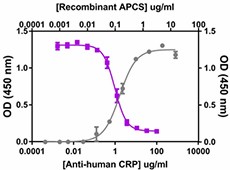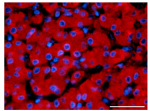- Clone
- A16065C (See other available formats)
- Regulatory Status
- RUO
- Other Names
- C-reactive protein (CRP), Pentraxin 1 (PTX1)
- Isotype
- Mouse IgG1, κ
- Ave. Rating
- Submit a Review
- Product Citations
- publications

-

Immobilized recombinant human CRP at 2 µg/mL binds recombinant human APCS (grey circles). Anti-human CRP antibody (clone A16065C, purple squares) inhibits the binding of recombinant human APCS (at 1 µg/mL) in a dose dependent manner as detected by functional ELISA. The ND50 = 0.4 - 2.0 µg/mL.
| Cat # | Size | Price | Quantity Check Availability | Save | ||
|---|---|---|---|---|---|---|
| 696003 | 100 µg | £178 | ||||
| 696004 | 1 mg | £490 | ||||
C-reactive protein (also known as CRP and Pentraxin 1 (PTX1)), is a member of pentraxin protein family. Similar to other pentraxins, CRP is a pattern recognition molecule that is able to recognize pathogens and promote their clearance. CRP tends to form a non-covalently linked pentamer with each subunit made up of two antiparallel β-sheets and a single short α-helix. It is characterized by the presence of a cleft that extends from the center of the subunit to its edge at the central pore of the pentamer structure. It has been demonstrated that CRP binds to the phosphocholine moieties expressed on the surface of dead or dying cells and some bacteria. This leads to the activation of the complement system and promotion of phagocytosis by macrophages to clear necrotic and apoptotic cells. CRP is secreted by hepatocytes and is a biomarker for inflammation. IL-6 has been shown to be an effective inducer of this protein. Besides binding to apoptotic cells, CRP also binds to a variety of molecules including C1q, bacterial polysaccharide, CD64, CD32, APCS, HDL, and fibronectin. In addition to participating in immune responses, CRP is also a prominent partaker in endothelial dysfunction and atherosclerosis. It was shown that CRP may exhibit direct proantherogenic effects by upregulating angiotensin type I receptor in smooth muscle cells and promoting their migration, proliferation, neointimal formation, and reactive oxygen species production. Mature human CRP shares 71% amino acid sequence homology with its mouse counterpart.
Product DetailsProduct Details
- Verified Reactivity
- Human
- Antibody Type
- Monoclonal
- Host Species
- Mouse
- Immunogen
- Recombinant human CRP/PTX1
- Formulation
- 0.2 µm filtered in phosphate-buffered solution, pH 7.2, containing no preservative.
- Endotoxin Level
- Less than 0.01 EU/µg of the protein (< 0.001 ng/µg of the protein) as determined by the LAL test.
- Preparation
- The Ultra-LEAF™ (Low Endotoxin, Azide-Free) antibody was purified by affinity chromatography.
- Concentration
- The antibody is bottled at the concentration indicated on the vial, typically between 2 mg/mL and 3 mg/mL. Older lots may have also been bottled at 1 mg/mL. To obtain lot-specific concentration and expiration, please enter the lot number in our Certificate of Analysis online tool.
- Storage & Handling
- The antibody solution should be stored undiluted between 2°C and 8°C. This Ultra-LEAF™ solution contains no preservative; handle under aseptic conditions.
- Application
-
Neut - Quality tested
- Recommended Usage
-
Each lot of this antibody is quality control tested by blocking the binding of recombinant human APCS (1 µg/mL) to immobilized recombinant human CRP (2 µg/mL). ND50 range: 0.4 - 2.0 mg/mL. It is recommended that the reagent be titrated for optimal performance for each application.
- RRID
-
AB_2686982 (BioLegend Cat. No. 696003)
AB_2686983 (BioLegend Cat. No. 696004)
Antigen Details
- Structure
- Monomer and homopentamer
- Distribution
-
Hepatocytes
- Function
- Induces expression of E-selectin and VCAM-1 expression in epithelial cells. CRP binds to target, initiates, and regulates complement activation. Induced by IL-1 and IL-6.
- Interaction
- Phosphocholine on the surface of apoptotic cells
- Ligand/Receptor
- Interacts with C1q, bacterial polysaccharide, CD64, CD32, APCS (PTX2), HDL, leptin, and fibronectin.
- Biology Area
- Cell Biology
- Antigen References
-
1. Ansar W, Ghosh S. 2013. Immunol. Res. 56:131.
2. Agrawal A, et al. 2009. Adv. Exp. Med. Biol. 653:98.
3. Garlanda C, et al. 2005. Annu. Rev. Immunol. 23:337.
4. Verma S, et al. 2004. Circulation 109:1914.
5. Wadham C, et al. 2004. Circulation 109:2116.
6. Li XA, et al. 1998. Biochem. Biophys. Res. Commun. 244:249.
7. Lu J, et al. 2012. Immunol. Rev. 250:230.
8. Chen K, et al. 2006. Nat. Med. 12:425. - Gene ID
- 1401 View all products for this Gene ID
- UniProt
- View information about CRP on UniProt.org
Related Pages & Pathways
Pages
Related FAQs
- Do you guarantee that your antibodies are totally pathogen free?
-
BioLegend does not test for pathogens in-house aside from the GoInVivo™ product line. However, upon request, this can be tested on a custom basis with an outside, independent laboratory.
- Does BioLegend test each Ultra-LEAF™ antibody by functional assay?
-
No, BioLegend does not test Ultra-LEAF™ antibodies by functional assays unless otherwise indicated. Due to the possible complexities and variations of uses of biofunctional antibodies in different assays and because of the large product portfolio, BioLegend does not currently perform functional assays as a routine QC for the antibodies. However, we do provide references in which the antibodies were used for functional assays and we do perform QC to verify the specificity and quality of the antibody based on our strict specification criteria.
- Does BioLegend test each Ultra-LEAF™ antibody for potential pathogens?
-
No, BioLegend does not test for pathogens in-house unless otherwise indicated. However, we can recommend an outside vendor to perform this testing as needed.
- Have you tested this Ultra-LEAF™ antibody for in vivo or in vitro applications?
-
We don't test our antibodies for in vivo or in vitro applications unless otherwise indicated. Depending on the product, the TDS may describe literature supporting usage of a particular product for bioassay. It may be best to further consult the literature to find clone specific information.
Other Formats
View All CRP (C-reactive protein) Reagents Request Custom Conjugation| Description | Clone | Applications |
|---|---|---|
| Ultra-LEAF™ Purified anti-human CRP (C-reactive protein) | A16065C | Neut |
| Purified anti-human CRP (C-reactive protein) | A16065C | WB,IHC-P |
Compare Data Across All Formats
This data display is provided for general comparisons between formats.
Your actual data may vary due to variations in samples, target cells, instruments and their settings, staining conditions, and other factors.
If you need assistance with selecting the best format contact our expert technical support team.
-
Ultra-LEAF™ Purified anti-human CRP (C-reactive protein)

Immobilized recombinant human CRP at 2 µg/mL binds recombina... -
Purified anti-human CRP (C-reactive protein)

Total U87-MG cell lysates (negative control) and human serum... 
IHC staining using purified anti-CRP (C-reactive protein) an...
 Login / Register
Login / Register 








Follow Us